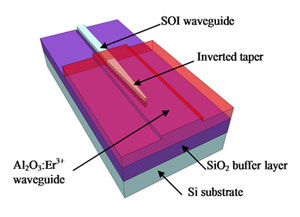Silicon-Erbium Chip Achieves 170 Gb/s
ENSCHEDE, Netherlands, Sept. 21, 2012 — The integration of silicon and an erbium-doped material on a single chip will amplify light at speeds up to 170 gigabits a second, says a doctoral student at the University of Twente who demonstrated a working prototype.
On optical microchips, light moves through channels, or waveguides, made of silicon. But silicon passively conducts the light; it cannot amplify it and even loses some of it along the way. To boost the signal, or even include a light source on the chip, other types of semiconductor materials, such as gallium arsenide, are used. Materials doped with the rare-earth material erbium also have good amplification properties.
In her thesis, PhD candidate Laura Agazzi demonstrated a working chip that combines silicon and an erbium-doped material, aluminium oxide. The prototype chip has a signal gain of 7.2 dB at the infrared wavelength of 1533 nm, she said, and will be able to achieve light amplification speeds of up to 170 Gb/s.
The results from the prototype are promising, and not just for communications, she said. One possibility is the creation of a laser with an extremely narrow linewidth of 1.7 kHz.

Image of the chip demonstrated by the University of Twente's Laura Agazzi, including silicon optical waveguide (SOI: silicon on insulator) and erbium-doped aluminium oxide. The integration of silicon and an erbium-doped material on a single chip will amplify light at speeds up to 170 Gb/s(Image: University of Twente)
"In any application that needs emission or amplification of light, this integration of both materials is useful. It is not limited to telecom. You could use these chips for sensor purposes, for tracing extremely small particles, for example," Agazzi said.
She investigated the optical properties of aluminium oxide doped with erbium to gain a better understanding of the mechanisms that negatively affect amplification, such as energy-transfer upconversion (ETU), which is detrimental for good functionality.
"If you want a large amplification, you would like to put many erbium ions in the material. This in turn can cause a higher ETU," Agazzi said. "There are possibilities in adapting the host material, causing less interaction of the ions. With my models, I have gained better insight in these and other mechanisms that lower the amplification."
Agazzi conducted her research within professor Markus Pollnau's Integrated Optical Microsystems Group, which is part of the MESA+ Institute for Nanotechnology at Twente.
On Thursday, Sept. 20, she successfully defended her thesis, "Spectroscopic Excitation and Quenching Processes in Rare-Earth-Ion-Doped Al2O3 and their Impact on Amplifier and Laser Performance."
For more information, visit: www.utwente.nl
Published: September 2012